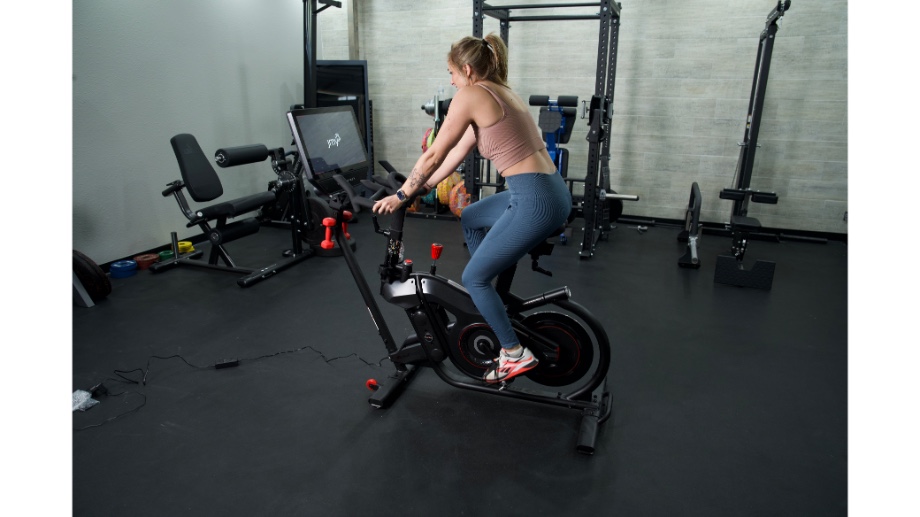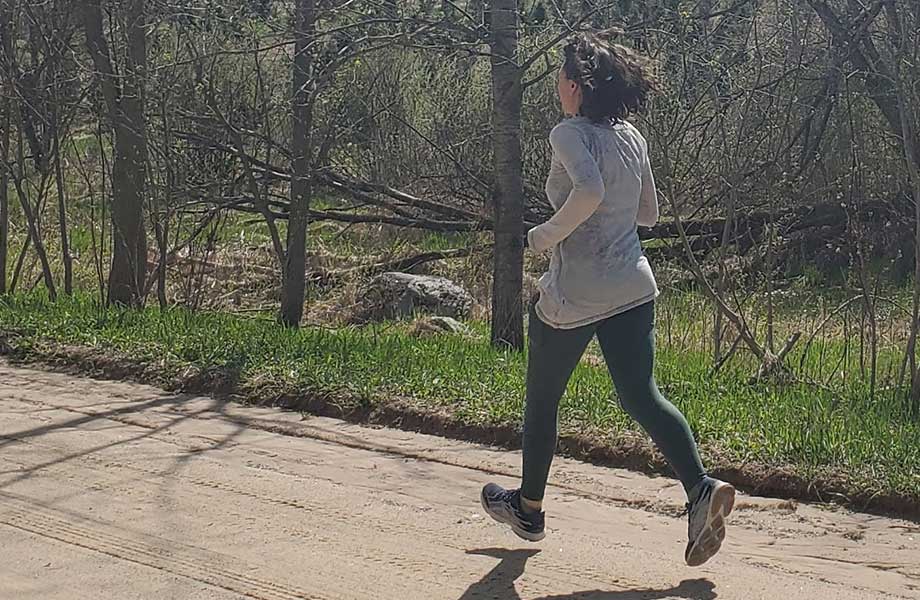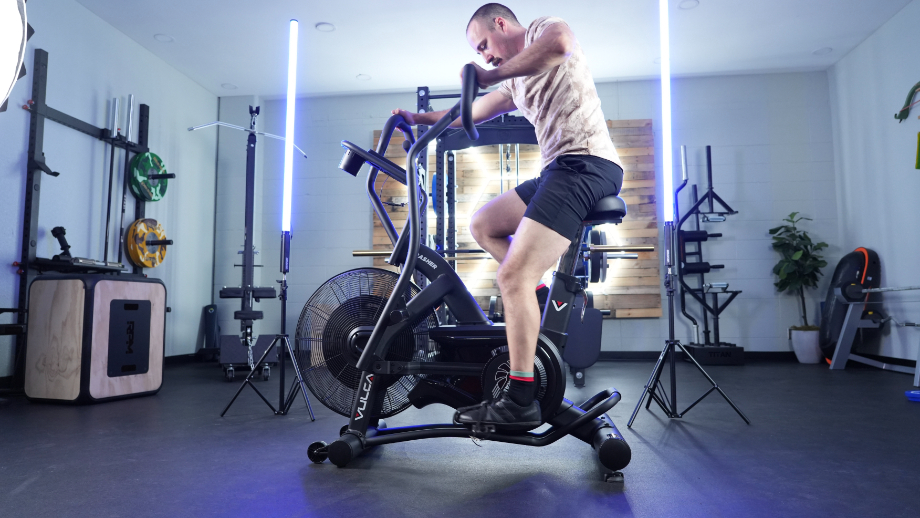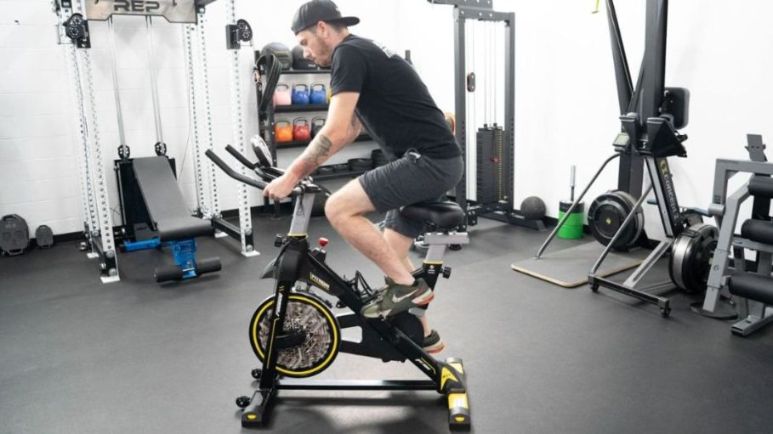We test and review fitness products based on an independent, multi-point methodology. If you use our links to purchase something, we may earn a commission. Read our disclosures.
Could spinning be the secret weapon to improving your running pace and crushing your marathon training plan? Or would adding indoor cycling training (or outdoor bike rides) to your workout routine hinder your ability to become a better runner?
Whether you’re a beginner or a battle-tested competitor, engaging in other forms of physical activity besides running isn’t just a recommendation, it’s a necessity. This concept—otherwise known as cross-training—offers several physical and mental health benefits that can help you avoid boredom, burnout, and injuries.
RELATED: Cross-Training for Runners
As a certified personal trainer (CPT), longtime rugby player, and self-described #IronAddict, I’ll be the first to tell you that your brain and body need balance. Even if you love lacing up your best running shoes, putting on your favorite playlist, and pounding the pavement, you should still include other forms of exercise in your training plan.
While cycling and running represent two excellent forms of cardiovascular exercise, pairing the two may seem like overkill (unless you’re a triathlete). However, based on my experience as a personal trainer and athlete, I’m here to dispel that notion and answer the question, ”Does biking help with running performance?”
So, if you’ve only been hitting the track or taking your normal route around the neighborhood, it’s time to get off your feet, sit on a seat, and pedal your way to better running performance.
Comparing Cycling vs Running Training
It’s no secret that aerobic exercises like cycling and running can pay big dividends for your health and overall fitness. Both forms of cardio raise your heart rate, burn calories, and engage different muscle groups. In both cases, your quads, glutes, hamstrings, and other leg muscles do a majority of the heavy lifting.
You must also engage your core muscles to maintain proper body position for either activity. However, there are also obvious differences between biking and running that make them unique.

RELATED: Cycling vs Running
On one hand, dedicated cyclists typically invest in a road bike or mountain bike to go on long rides. Many also keep a stationary bike in their home or garage gym as another avenue to improve their cardiovascular fitness and cycling performance.
Even though high-quality running shoes cost around $140 on average, that pales in comparison to the cost of an exercise bike, which can easily cost thousands of dollars, depending on the type of features you need. From an accessibility standpoint, there’s a higher cost of entry to become a good cyclist.
RELATED: Best Exercise Bikes
While cycling is a low-impact, non-weight-bearing form of aerobic training, running places much more stress on your joints, ligaments, and tendons. Whether you’re covering long distances to prepare for a half marathon or cranking out a high-intensity sprint workout, your knees, hips, ankles, and feet face a far more demanding challenge.
The high impact of running on your joints can make it tough to sustain a consistent training schedule, especially if you’re not consistently foam rolling, stretching, and using other active recovery methods. Of course, this is the case for any type of exercise modality, including strength training. But, because running can take such a toll on your body, competitive runners must be particularly diligent about striking the right balance of training and recovery/rest to avoid overuse injuries1.
RELATED: Workout Recovery Myths
5 Ways Biking Can Help Improve Your Running Performance
Even if you don’t have aspirations to compete in a duathlon or triathlon, you can leverage the benefits of cycling to help improve your running performance. From enhancing muscle strength to being a low-impact activity, here’s how cycling can boost your running fitness and performance.

1. Cycling Can Mimic the Posture of Running
While a recumbent bike doesn’t offer much help in terms of mimicking your running form, you can cycle out of the saddle of a standard exercise or road bike with your body as vertical as possible to emulate the posture of running. This allows you to activate your quads, glutes, hamstrings, and calves in a similar fashion as you would if you were on your feet. In addition, you have to engage your core to maintain an upright body position just like you do when running.
RELATED: Good Running Form for Beginners
2. Cycling Can Help Increase Your Aerobic and Anaerobic Capacity
You don’t have to spend an inordinate amount of time on the track, treadmill, or open road to develop your aerobic and anaerobic fitness. Biking offers another avenue to improve your VO2 max and cardiovascular stamina.
A 2015 study published in the Journal of Strength and Conditioning Research2 on the impact of high-intensity cycling training showed that different work-to-rest intervals can have a significant impact on running performance. The first group cycled in 30 seconds of work intervals with 30 seconds of rest. The second group followed an equal work-to-rest ratio of 1 minute, and the third group did so for 2 minutes.
Researchers measured several metrics—including VO2 max, 5K time, and run economy—and found that the first group showed the most significant improvement in VO2 max and run economy (the amount of oxygen your body uses at a certain intensity). That means you don’t have to spend a ridiculous amount of time on a bike to set yourself up for more success on the track or treadmill.
RELATED: HIIT Bike Workout
3. Cycling Is a Low-Impact Cardio Workout
Ask longtime runners about the state of their joints and you’re bound to get at least a few moans and groans about painful hips, knees, and ankles. Even if you wear comfortable, well-cushioned running shoes like the HOKA Clifton 9, your joints still have to absorb the repeated impact of your feet hitting the ground.
However, cycling eliminates that aspect by providing a low-impact alternative to running. If you’re working your way back from an injury, a bike is a safe, effective way to train that won’t place a heavy demand on your joints. Or, you can use cycling as an opportunity to scale things back a bit if you’ve been going too hard.
RELATED: Best Low-Impact Cardio Exercises

4. Cycling Can Increase Your Muscular Strength
Just like running, biking activates all of your lower-body and core muscles. In particular, you can get a great calf workout cycling out of the saddle. Strengthening your soleus (your deep calf muscle) can assist with your running performance, as this muscle is responsible for absorbing force.
In addition, pulling the pedal upward during the upstroke from a seated position effectively engages your tibialis anterior (your shin muscle). Making this muscle stronger can help prevent shin splints3—a common problem runners face.
RELATED: How to Increase Strength
5. Cycling Can Be Great for Active Recovery
What should you do the next day after a demanding run or race? Besides refueling, you can hop on a stationary bike or take your road bike out for an active recovery session.
There’s no need to be a speed racer trying to win the Tour de France. Keep the intensity low, letting your leg muscles get some movement to promote blood flow. This can be especially beneficial for dealing with delayed-onset muscles soreness4 (DOMS)—a painfully familiar experience for many cyclists, runners, and athletes.
RELATED: Does Cycling Build Muscle?
Cycling Training Tips for Runners
Now that I’ve convinced you to hop on the bike bandwagon, I’ll give you a few tips that’ll set you up for long-term success at your running endeavors:
- Try a hybrid workout where you ride your bike for 15-20 minutes and then go on a 15- to 20-minute run (or vice versa) to test your physical and mental fortitude.
- Include at least one longer bike ride per week to give your body and brain a break from running. This can also be a great way to explore a new area or get your family and friends involved in fitness.
- Vary the work-to-rest ratio with your HIIT bike training to keep making progress. Remember, the total amount of time you spend won’t be long, but you can make things much more challenging by using a 2:1 work-to-rest ratio.
- Experiment with different positions on the bike, including riding out of the saddle (standing up) and remaining seated. Depending on the type of exercise bike, you can also change the resistance level to force your leg muscles to work even harder.
- Keep a water bottle on hand during your cycling sessions to stay hydrated. I also recommended mixing in an electrolyte powder to ensure you have adequate sodium, magnesium, and potassium levels.
RELATED: Best Electrolyte Powder

Does Biking Help With Running? Final Thoughts
Cycling and running go hand-in-hand like an Olympic barbell and weight plates. Both forms of cardio offer valuable health benefits, with the former offering a low-impact alternative to the latter’s physically demanding nature. Combining the two modalities—aka cross-training—can allow you to reap the rewards while reducing your risk of overuse injuries and mental burnout.
As a CPT, I’m also a strong advocate of strength training for runners (and cyclists), as building and maintaining lean muscle is imperative for overall health and longevity. So, in addition to working on your cycling fitness and running technique, pencil resistance training into your workout plan at least two days a week to give your mind and body the balance it deserves.
Does Biking Help With Running? FAQs
Does biking help with running stamina?
Biking can help you improve your running stamina by increasing your overall cardiovascular fitness. As a certified personal trainer, I recommend a mix of long-distance rides and high-intensity interval training (HIIT) cycling workouts for balance.
Does cycling strengthen muscles for running?
Yes, cycling effectively engages and strengthens your leg muscles, including your quads, hamstrings, glutes, and calves. This can have a positive impact on your running performance, as you can generate more power and speed.
Is it OK to run and bike everyday?
As a certified personal trainer and longtime athlete, I would not recommend running and biking daily. Include at least 1 to 2 rest days in your workout plan for optimal recovery.
Can biking make you run faster?
Biking can help you run faster by enhancing your muscular strength and endurance, both of which contribute to your ability to complete a speedier run.
References
- Ferber, R., Hreljac, A., & Kendall, K. D. (2009). Suspected mechanisms in the cause of overuse running injuries: a clinical review. Sports Health a Multidisciplinary Approach, 1(3), 242–246. https://doi.org/10.1177/1941738109334272
- Kavaliauskas, M., Aspe, R. R., & Babraj, J. (2015). High-Intensity cycling training. The Journal of Strength and Conditioning Research, 29(8), 2229–2236. https://doi.org/10.1519/jsc.0000000000000868
- Bhusari, N., & Deshmukh, M. (2023). Shin Splint: A review article. Cureus. https://doi.org/10.7759/cureus.33905
- Cheung, K., Hume, P. A., & Maxwell, L. (2003). Delayed onset muscle soreness. Sports Medicine, 33(2), 145–164. https://doi.org/10.2165/00007256-200333020-00005
Further reading

We’ve got seven tips for running in the heat, and how to know when to take your run indoors. Read more

Our Onnit Total Human review is based on weeks of testing Joe Rogan’s favorite multivitamin stack. Here are our honest thoughts. Read more

In this Legion Creatine Gummies review, our expert tests out this clean creatine gummy to see if it’s worth adding to your supplement stack. Read more

In our Sole SB700 review, find out how this sturdy, well-built bike compares to others on the market. Read more

